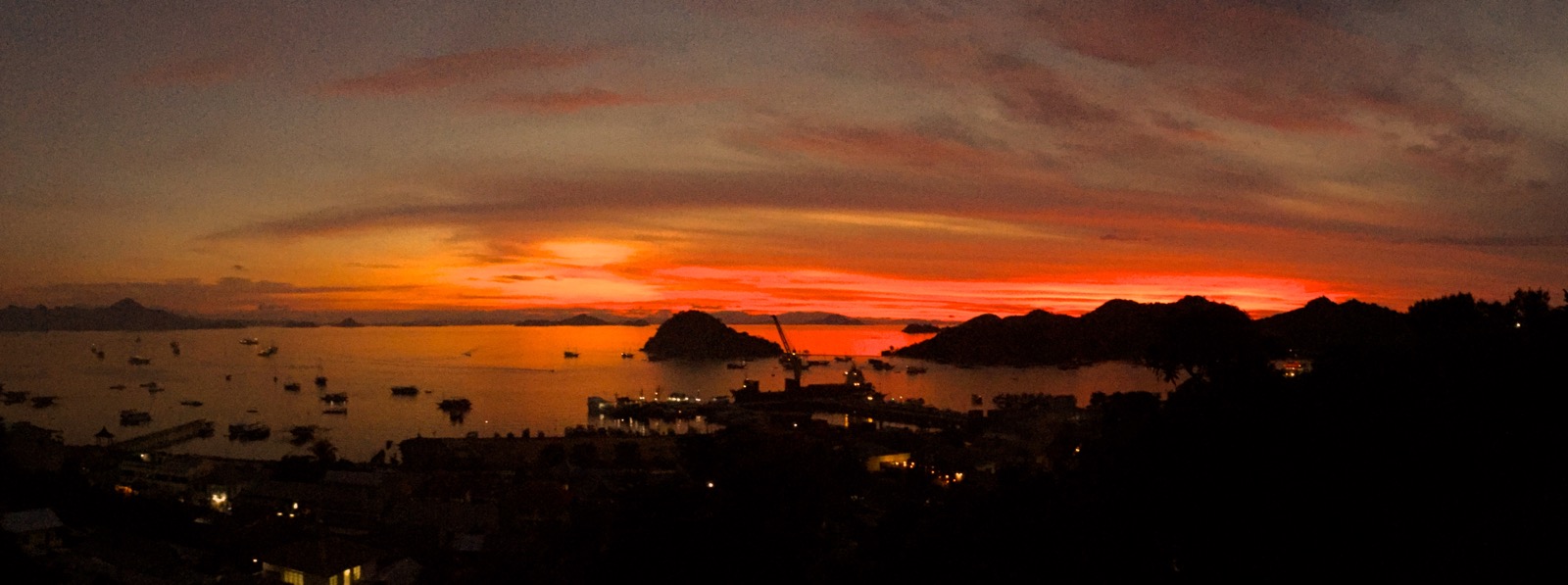We saved the best for last.
We wanted to dive in Komodo National Park since the moment we arrived in Indonesia. The diving in the Gilis, Bunaken, and Lembeh was extraordinary, but all the other divers we spoke to put Raja Ampat and Komodo National Park in a league of their own. Raja Ampat has stormy seas this time of year, so we’ll save it for our next trip. But Komodo beckoned.
In Komodo, a convergence of the warm Flores Sea and cold Indian Ocean gives rise to strong currents and dense plankton that draw enormous schools of fish, sharks, manta rays, and more. The strong currents that make the diving spectacular also make it more challenging. Novice divers can get quickly whisked far from the reef, like five unlucky Europeans who were swept out to sea and had to swim 36 hours across open ocean to fight their way back to dry land . . . only to be attacked by the famous Komodo dragon when they reached shore. Even more daunting are strong down currents in the deep waters, which can pull you down into the depths. But the risk is minimal for prepared divers following instructions of an experienced dive guide, so we saved Komodo until last – when our diving skills were at their peak.
Labuanbajo is the jumping off point for Komodo National Park. On Flores’ western shore, this little harbor town ends each day with dramatic sunsets over the sea. As the fiery-red horizon fades, an evening fish market comes to life, where the day’s catch is cleaned, seasoned, and grilled over hot coals just steps from your table.
 Sunset over Komodo National Park, from our hotel balcony.
Sunset over Komodo National Park, from our hotel balcony.
We did two long diving day-trips into Komodo while at Labuanbajo. But the highlight was a four day expedition aboard the Jaya – a “liveaboard” operated by Wicked Diving. Freed from the need to shuttle back-and-forth to Labuanbajo, the liveaboard has a lot more flexibility to hit dive sites when the current is just right, which translates directly into more abundant, active wildlife.
Living at sea was a first for us. We loved it. Spending nights at sea created a immersive world all its own, shared by just us and our small crew amidst the waves. The world beyond fell away.
The livaboard staff impressed us again and again. This all-star crew all had 15-20 years of experience. In addition to guiding us, they were training three young Indonesians, who were in the midst of a rigorous, year+ training to be dive guides – at no cost to the aspiring guides. We were especially inspired by Sari, who, at just 19, has poise well beyond her years and is on track to become the first female Indonesian guide in all of Komodo National Park.
Besides us, there were just three other guests on board: Matthes, a German who is starting an Indonesian furniture-import business, and splitting his time between the two countries; and Lawrence and his 13-year-old son Julian, Canadians in the middle of a six-month Asian adventure.
Lawrence and Julian inspired and intrigued us – we love meeting families that have found ways to keep extended global travel in their lives. Lawrence teaches online, having spent years cultivating a completely virtual professional life that leaves him freedom of travel. His wife is taking a sabbatical from a more traditional professional career, and they’ve moved their family to Kuala Lumpur for the year. Julian skipped the second half of eighth grade to travel with his parents from their base in Kuala Lumpur: India, Cambodia, Japan, and now Indonesia.
As part of this self-assembled study-abroad, Lawrence and Julian signed up to do a “manta ray specialty course” aboard the Jaya, which meant educational opportunities for all of us and some shared laughs involving a human-sized manta ray costume and impressive manta-ray origami. We learned that Wicked has helped sponsor some impressive citizen science by its guests: by creating a large pool of photos to help track manta migrations, divers have contributed to critical research and conservation for the threatened rays.
Our diving days aboard the Jaya were truly special. In Gili, we loved the turtles gracefully swimming through crystal clear waters. In Bunaken, the draw was the stunning coral cliffs. In Lembeh, we were heads down in the muck, finding crazy creatures. Komodo had a piece of all of these, and numerous charms all its own. We saw gorgeous coral, dramatic landscapes, sleeping turtles, and rare critters like frog fish, leaf scorpionfish, and octopi (yes, plural!). But many times it was impossible to focus on any one feature amidst the marine activity in all directions.
Take sharks. Sharks are big, dramatic, rare. At Gili, Robynn saw two sharks, and Michael saw none. At Bunaken, we spotted three young sharks hiding in a cave along the cliffs. At Castle Rock in Komodo, there were too many sharks to count – and they wove in and out of hundreds of brightly colored smaller fish in schools of ever-changing shapes. Often, we just hovered in the water and watched it all spin around us – a kaleidoscopic whirl greater even than the sum of its individually magnificent parts.
Komodo’s big underwater star is the manta ray. Despite four hours of accumulated dives at Komodo’s manta sites, we saw just two – one a vauge shadow in the distance. But our second manta encounter was close and every bit as magical as advertised. The giant, 2.5-meter broad animal glided right up to us. We could have reached out and touched it if that were allowed. It paused, and then swept away into the blue.